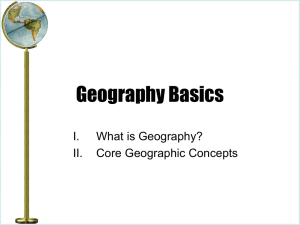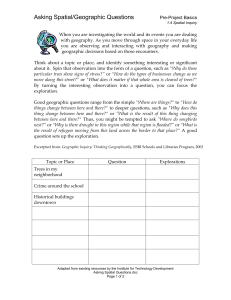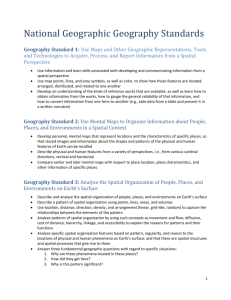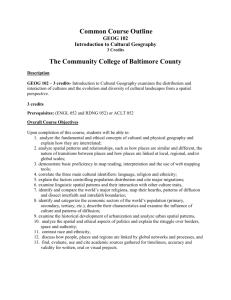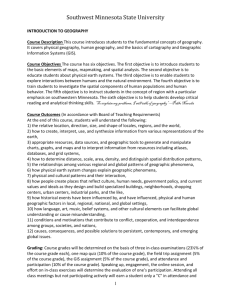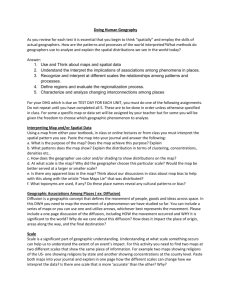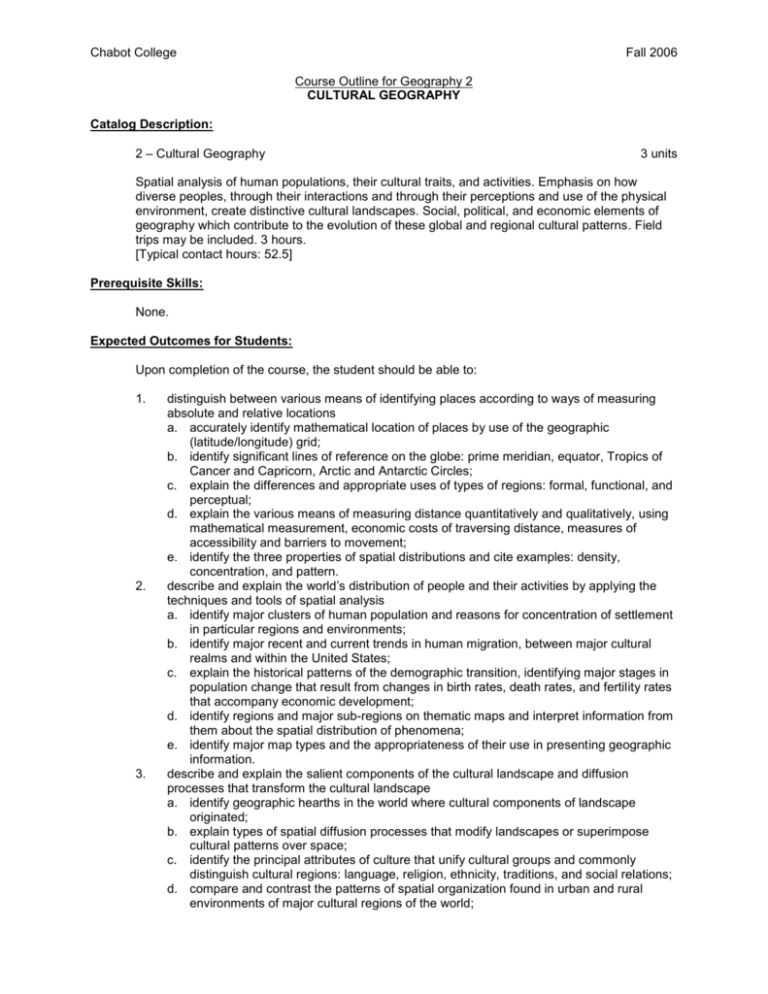
Chabot College
Fall 2006
Course Outline for Geography 2
CULTURAL GEOGRAPHY
Catalog Description:
2 – Cultural Geography
3 units
Spatial analysis of human populations, their cultural traits, and activities. Emphasis on how
diverse peoples, through their interactions and through their perceptions and use of the physical
environment, create distinctive cultural landscapes. Social, political, and economic elements of
geography which contribute to the evolution of these global and regional cultural patterns. Field
trips may be included. 3 hours.
[Typical contact hours: 52.5]
Prerequisite Skills:
None.
Expected Outcomes for Students:
Upon completion of the course, the student should be able to:
1.
2.
3.
distinguish between various means of identifying places according to ways of measuring
absolute and relative locations
a. accurately identify mathematical location of places by use of the geographic
(latitude/longitude) grid;
b. identify significant lines of reference on the globe: prime meridian, equator, Tropics of
Cancer and Capricorn, Arctic and Antarctic Circles;
c. explain the differences and appropriate uses of types of regions: formal, functional, and
perceptual;
d. explain the various means of measuring distance quantitatively and qualitatively, using
mathematical measurement, economic costs of traversing distance, measures of
accessibility and barriers to movement;
e. identify the three properties of spatial distributions and cite examples: density,
concentration, and pattern.
describe and explain the world’s distribution of people and their activities by applying the
techniques and tools of spatial analysis
a. identify major clusters of human population and reasons for concentration of settlement
in particular regions and environments;
b. identify major recent and current trends in human migration, between major cultural
realms and within the United States;
c. explain the historical patterns of the demographic transition, identifying major stages in
population change that result from changes in birth rates, death rates, and fertility rates
that accompany economic development;
d. identify regions and major sub-regions on thematic maps and interpret information from
them about the spatial distribution of phenomena;
e. identify major map types and the appropriateness of their use in presenting geographic
information.
describe and explain the salient components of the cultural landscape and diffusion
processes that transform the cultural landscape
a. identify geographic hearths in the world where cultural components of landscape
originated;
b. explain types of spatial diffusion processes that modify landscapes or superimpose
cultural patterns over space;
c. identify the principal attributes of culture that unify cultural groups and commonly
distinguish cultural regions: language, religion, ethnicity, traditions, and social relations;
d. compare and contrast the patterns of spatial organization found in urban and rural
environments of major cultural regions of the world;
Chabot College
Course Outline for Geography 2, Page 2
Fall 2006
4.
5.
6.
7.
e. explain the historical and contemporary influences of colonialism on patterns of
settlement, land tenure, boundaries, and structures.
articulate the major geographic issues and trends in the contemporary world
a. distinguish between developed and developing regions and nations based on
economic, political, and social indicators;
b. identify types of globalization trends and processes operating on the global scale using
spatial indicators;
c. recognize the forces of diversity and ethnic identity at work in regions that counter
globalization trends and cause devolution;
d. describe the internal characteristics of countries and regions that illustrate growing
regional disparities in economic development and spatial biases in the provision of
infrastructure;
e. compare the status of indigenous peoples, women, and minority populations in different
cultural contexts;
f. identify global environmental change concerns and trends in the context of the strongly
interconnected Earth system: global warming, land degradation, air and water quality,
and natural hazards.
sketch the history of geographic ideas from the ancient world to the 20th century
a. assess the role of cosmologies in major civilizations and periods in affecting attitudes
about the environment and humanity’s role in it;
b. explain the impact of the European Age of Exploration on the expansion of knowledge
about places and viewpoints on nature;
c. describe the influence of Darwinism and the growing body of scientific knowledge in the
19th century on the development of the human-nature dichotomy.
explain the relationship of sustainable environments to changing patterns of population,
food production, increasing urbanization, and human-induced environmental change
itemize the analytical tools and techniques most widely used in contemporary geographic
research
a. give examples of remote sensing instrumentation used in monitoring environmental
change through time;
b. describe the essential components and basic architecture of geographic information
systems (GIS) and tools they provide for accurate mapping and spatial analysis;
c. explain the operational characteristics of global positioning systems (GPS) and how
precise mathematical measurement of location facilitates updating of maps and
provision of data for GIS.
Course Content:
1.
2.
3.
Spatial concepts
a. Early mapping in western and non-western cultures
b. Elements of maps: scale, projections, thematic types
c. Concepts of space and place: location, site, situation
d. Measurements of absolute and relative location
1)
The geographic grid: latitude and longitude
2)
Distance, accessibility, and barriers to movement
e. Characteristics of spatial distributions
Organizing principles in geography
a. Types of regions
b. Relationships in spatial association
c. Spatial diffusion processes
d. Geographic concepts of culture
1)
Regionalization of culture
2)
The cultural landscape
World population patterns and dynamics
a. Major regional population clusters
Chabot College
Course Outline for Geography 2, Page 3
Fall 2006
4.
5.
6.
7.
8.
b. Means of measuring population distributions and change
1)
Density of population
2)
Birth rates
3)
Death rates
4)
Fertility rates
5)
Age distributions: population pyramids
c. Stages of population growth: the demographic transition
d. Population growth and sustainability
Migration processes and inter-regional patterns
a. Push-and-pull factors in migration
b. Historical and contemporary global patterns
c. Patterns of U.S. immigration
d. Stages of U. S. internal migration
e. Impact of immigration policies and cultural nationalism
Elements and evolution of the cultural landscape
a. Agricultural origins
b. Tangible and intangible components of landscape
c. Spatial diffusion of innovations and technology
d. Spatial diffusion of language families and religion
e. Sacred spaces and places
f. Evolution of thinking in the human-nature dialog
g. Cultural ecology
Contemporary issues and processes in cultural and regional change
a. Indicators of economic development
b. Globalization and devolution
c. Regional disparities
d. Impacts of colonialism and neocolonialism
e. Political, demographic, and technological changes of the 20th century that altered the
world map
f. Cultural coherence and spatial diversity
1)
ethnolinguistic boundaries
2)
religious hearths and spheres of influence
3)
patterns of ethnicity in rural and urban realms
g. Political organization of space
1)
development of the nation-state idea
2)
shapes, sizes, and scales of states
3)
boundary issues
4)
nationalism, multinationalism, and international organizations
h. Global environmental change and human ecology
History of cultural thinking about geography and environment
a. Classical cosmography of the ancient western world
b. Early descriptive geography and mapping in China and Islamic world
c. Age of exploration and discovery
d. Compilations of expanding geographic knowledge
e. Advances in mapping techniques and technology
f. Darwinism and the advances of science
g. Environmental determinism and possibilism
Location theory and locational patterns of economic activities
a. Agricultural hearths and diffusion of agricultural systems
b. Classifications of subsistence and commercial agriculture
c. Factors in industrial location
d. Regional specialization in economic sectors
e. Impact of technology and the information economy
f. Urban settlement
1)
Cultural variations in urban internal structure
Chabot College
Course Outline for Geography 2, Page 4
Fall 2006
9.
2)
Locations of services in modern economies
3)
Models of urban form
4)
Trends in urbanization
Modern analytical tools and technologies in geography
a. Remote sensing of environment
1)
Advances in digital imaging
2)
Satellite technologies
b. b. Geographic Information Systems (GIS)
1)
Geocoding and spatial overlay
2)
Mapping spatial relationships
c. Global Positioning Systems (GPS)
Methods of Presentation:
1.
2.
3.
Lecture
Maps, slides, transparencies, videotapes, webpages, and online links
Class discussions and student presentations
Assignments and Methods of Evaluating Student Progress:
1.
2.
Typical Assignments
a. map and label the principal sub-regions, physical features, cultural regions, and urban
centers on a regional basemap
b. prepare an in-class oral presentation or online presentation about a region, which may
include:
1)
audio/visual components
2)
maps, charts, and diagrams
3)
computer-based learning resources (e.g., Internet links, tutorial modules)
c. write an essay on a researched environmental or cultural issue
d. comment on a recent news event (e.g., 9/11 attacks, Hurricane Katrina) in terms of its
spatial scope, cultural response, or landscape impacts
1)
online interactive discussion forum with other students
2)
brief statement or essay
e. write a review of a supplemental reading selection from newspapers, the periodical
literature, or Internet sites
Methods of Evaluating Student Progress
a. performance-based evaluation structured around principal geographic concepts and
subfields
1)
examinations and quizzes, in-class or online
2)
map quizzes, in-class or online
3)
final examination
b. oral or online visual/audio presentation(s) to assess student’s understanding of various
approaches
to geographic knowledge and student’s ability to clearly organize and express
geographic data and concepts
c. participation in classroom activities and discussions, or online discussions
d. email feedback about student presentations and discussions
Chabot College
Course Outline for Geography 2, Page 5
Fall 2006
Textbook(s) (Typical):
The Cultural Landscape: An Introduction to Human Geography, Rubenstein, J. M., Pearson, Prentice
Hall, 2005.
Human Geography: Landscapes of Human Activities, Fellman, J. D., Getis, A., and Getis, J., McGraw-Hill,
2005.
The Human Mosaic: a Thematic Introduction to Cultural Geography, Jordan-Bychkov, T. G., Domosh, M.,
Neumann, R. P., and Price, P. L., W. H. Freeman, 2006.
Human Geography: Culture, Society, and Space,, de Blij, H. J. and Murphy, A. B., John Wiley & Sons,
2003.
Special Student Materials:
None.
tf:/Word/Geog 2.doc
Revised: 11/1/05


